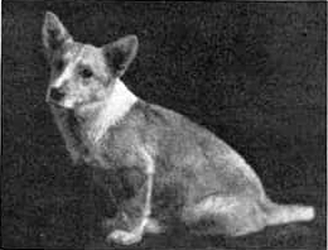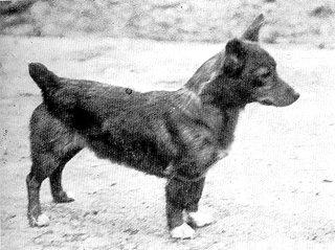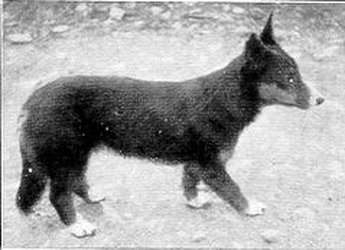Dogs of the Day - A Little One from Wales
By A. Croxton SmithAlthough the domestic canidae of the Principality cannot be said to be extensive, our Welsh friends have already succeeded in bringing out one variety that has met with unusual success in little more than a dozen years - I mean, of course, the Sealyham. The Welsh terrier has yet to reap his deserts. That he does deserve a wider popularity than he has attained will be agree by all who know him, but it may be that he is not showy enough to catch the eye of the public, who do not always look beneath the surface. After that charming little fellow, the Welsh springer, has been mentioned we have almost exhausted the list, but not quite.
Another claimant has appeared in downright earnest is the corgi, the "r" in which must be rolled with a hard sound if you would rapture the pronunciation of his human compatriots. It is many years ago since I read about the Welsh "heeler", otherwise the little cattle dog that derived his nickname from a propensity to nip the lower part of the hind legs of the kine he might be driving. Nature, by giving him short legs, had specially fitted him for the work, because he could drop easily in avoidance of the customary kick. Later on the corgi cropped up again in connection with the discussion on the making of the Sealyham, some holding that he was used in the process - a hypothesis that I should venture to doubt purely on a priori reasoning. Whence come the drop ears, the colour, and other features of the terrier that are so dissimilar! Precious little of the cattle dog remains, if any of him was ever there.
We must give precedence to the corgi as a breed. True, he may not be as old as the Welsh hills, but there seems to be no doubt that he is of respectable antiquity, and that he has a penchant for sport as well as an aptitude for homelier duties. Now, however, another destiny is in store for him, his admirers, first forming the inevitable club, having determined to launch him upon a show career. As in the case of the Sealyham, his debut was made in south Wales, his affairs being very much in the hands of the same men, Captain J.H. Howell, Master of the Pembrokeshire Hounds, was, I believe, mainly responsible in the first instances. It is, therefore, appropriate that the first mention of the cur dog should be in the laws of Howel the Good, King of South Wales in the tenth century. Although it is natural to use the word "cur" in connection with a dog so named, etymology has it that corgi is derived from the Cymric cor, a dwarf, and gi, a dog.

The Pembrokeshire type:
Mr. J. Williams' Welsh Corgi puppy. Dewland Betty.
Captain Howell is chairman of the committee of the Welsh Corgi Club, the president of which is Major C.W.M. Price, M.P., and the hon. secretary, Captain G. Checkland Williams, The Treasury, St. Davids. The special protégé of the club is the Pembrokeshire dog, but before he had been long in the field another Richmond appeared, this being the Cardiganshire variety, which also has its own guardian body, the Cardigan Welsh Corgi Club. The Earl of Lisburne is president, Mr. J. Jordan Jones, J.P., Llanarth, chairman, and Mr. D. Edwardes, "Tanffynon", Penuwch, Tregaron S.O., Cardiganshire, hon. Secretary. So much for the personnel of the supporters of the two varieties.
What of the dogs! Our photographs help readers to visualize the differences between them, which are made apparent in the standards. That of the Pembrokeshire variety requires a head shaped like that of the fox, wide between the ears, which are erect, set wide apart, and carried outwards. The jaw, of medium length, is rather inclined to be snipy. Eyes well set, round, and of medium size. Yellowish, light brown in colour. Neck fairly long and strong. Chest broad and deep, and well let down between the legs. Body of medium length. Tail short, as in the Sealyham. It is said that at least 75 per cent, are born with short tails. Ribs well sprung. Hindquarters strong and flexible (ham shaped). Legs short and straight as possible, with feet like those of the collie. Coat of medium length and dense. Colour, red or red-and-white. Weight, 18 lb. to 30 lb. Height not exceeding 14 in. at shoulder.

A typical Pembrokeshire Corgi:
Note the short tail and foxy head.
The Cardiganshire variety also has the foxy head, but the eyes are almond-shaped, and preferably dark in colour; the ears may be erect or semi-erect; the tail is long, and any colour is permissible except pure white. Height should not exceed 15 in., and the weight is from 18 lb. to 25 lb. The last clause of the standard says that "the body should measure about one yard from the point of nose to tip of tail, the prick ears and sharp eyes giving that alert expression of the fox." It will thus be seen that genuine differences exist, and people are now wondering if it would be possible, by a process of give and take, to get rid of them.

The type in which the tail is long:
Tanffynon Tango, Cardigan Welsh Corgi>
I do not care to express any decided opinion until I have inspected both varieties at Cruft's show at the Royal Agricultural Hall on Wednesday and Thursday next. With his unerring instinct for catching anything new, Mr. Cruft is patting on thirteen classes, making ample provision for each variety. With the exception of one exhibited by Mr. J. Williams, of Dulwich, at a Crystal Palace show in the autumn, we have not had the opportunity of seeing any of the little dogs in London, and these benches are sure to attract many visitors. It is as well to remind people of their presence, since, amid such a wealth of good things in the doggy way, they might be overlooked. The show will be almost overwhelming in its magnitude, especially in Alsatians, gundogs, and terriers.
Mrs. Partridge, of Evesham, is getting together a kennel of the Cardigan variety, and Mr. Edwardes has a dozen or more. Mr. Edwardes, who has given me some interesting notes on the breed, says: "In the past the corgi has only been in the hands of the upland farmers and smallholders, who managed to keep them pure. Years ago it used to be the premier breed in mid-Wales, until the advent of the sheepdog from Scotland sent it on the downgrade. The corgi was used for chasing ponies and cattle. They are very strong for their size, and most sporting little dogs, being frequently used in badger-digging or after foxes. Many instances are recorded of corgi finishing full-grown foxes single handed. Country ramblers and anglers need have no fear of meeting a bull if they have one with them. They are excellent ratters and rabbiters, and I have seen some working with a gun as well as any spaniel. They are also wonderful companions, being good pals but bitter enemies. It is a great pity that the old breed has not been brought into prominence before, but it was not in the possession of people who would do it. Owners were contented with what they had out of them in work, and little attention was paid to the selection of the best type. They are long lived. I saw one the other day that was sixteen years old, and still going strong".
I fully endorse Mr. Edwardes' hope that they will not be bred only for show points, but for working qualities as well. The Cymric plural form of the name, by the way, is Corgwn, but I suppose we shall fall into the habit of calling them just corgis.
The Illustrated Sporting and Dramatic News
February 3, 1927
15.05.2021
